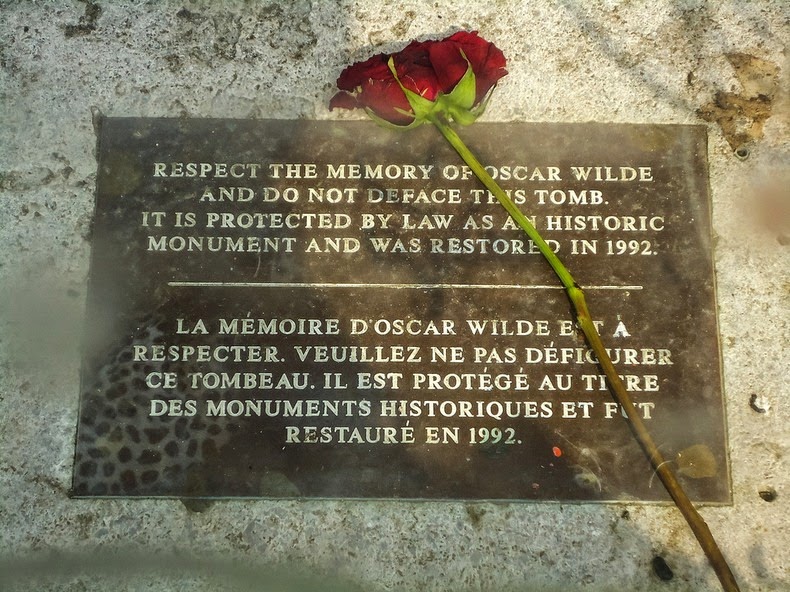A SEPULTURA DE OSCAR WILDE COBERTA DE BATON
Texto: Português / Inglês
O memorial do famoso escritor irlandês do século 19 e poeta, Oscar Wilde, encontra-se em um cemitério em Paris. Esculpido de um bloco de 20 toneladas de pedra, do túmulo apresenta uma figura alada que lembra a esfinge em um vôo para a frente com as asas na vertical estendidos, e é suposto ser baseado em poema de Wilde A Esfinge e inspirado por figuras assírias do Museu Britânico. Por anos, os fãs do sexo feminino têm visitado a enorme memorial no maior cemitério Pére Lachaise de Paris para homenagear o dramaturgo irlandês e deixaram a sua marca em batom vermelho. Ao longo de milhares de beijos de batom e mensagens de graffiti cobrir a metade inferior da tumba.
A prática começou no final de 1990, quando alguém decidiu deixar um beijo de batom no túmulo. Desde então, beijos de batom e os corações foram unidos por uma erupção de graffiti vermelho contendo expressões de amor, como: "Wilde criança que me lembro de você", "Continue olhando para as estrelas" e "beleza real termina onde começa o intelecto". Beijar o túmulo de Oscar no circuito turístico de Paris tornou-se um passatempo cult.
Oscar Wilde's Lipstick-Covered Tomb in Paris
The memorial of the famous 19th century Irish writer and poet,
Oscar Wilde, lies in a cemetery in Paris. Chiseled out of a 20-tonne
block of stone, the tomb features a winged figure resembling the Sphinx
on a forward flight with vertically outstretched wings, and is supposed
to be based on Wilde's poem The Sphinx and inspired by the
British Museum's Assyrian figures. For years, female fans have visited
the huge memorial in Paris's largest cemetery Pére Lachaise to pay
homage to the Irish playwright and left their mark in red lipstick. Over
thousands of lipstick kisses and graffiti messages cover the bottom
half of the tomb.
The practice started in the late 1990s, when
somebody decided to leave a lipstick kiss on the tomb. Since then
lipstick kisses and hearts have been joined by a rash of red graffiti
containing expressions of love, such as: "Wilde child we remember you",
"Keep looking at the stars" and "Real beauty ends where intellect
begins". Kissing Oscar's tomb on the Paris tourist circuit has become a
cult pastime.
Photo credit
A fine of €9,000 ($12,000) was imposed on anyone caught kissing or damaging the historical monument, but it had no effect. It was hard to catch people in the act, and most culprits were tourists who were long gone before the police could bring them to court. Appeals from Wilde’s grandson Merlin Holland to stop the practice also fell on deaf ears. A plaque asking fans to respect the tomb instead of defacing it went in vain.
Meanwhile, those greasy red lipstick stains seeped into the stone making it harder and harder to clean. Every cleaning eroded a layer of stone rendering it even more porous, so the next cleaning had to go even deeper and wear away the stone even more.
In 2011, on the the occasion of Oscar Wilde’s 111th death anniversary, the authorities put up a glass barrier surrounding the tomb to prevent kissers from causing further damage. But now tourists are leaving kisses on the glass instead and flowers and notes were tossed inside the enclosure and now lie strewn at the tomb’s foot.
Oscar Wilde died bankrupt and desolate and his friends could offer him only a sixth-class burial at Bagneux, outside the city. Over the following years his friend and literary executor, Robert Ross, managed through the sale of Wilde's works, to annul Wilde's bankruptcy and purchase a burial plot at Père Lachaise. The following year Helen Carew, one of Ross's friends who had known Wilde in his heyday, anonymously offered £2,000 to erect a monument by the young sculptor Jacob Epstein.
When the sculpture was brought into the cemetery, the Parisian officials were offended by the angel’s nakedness and attempted to cover it with tarpaulin. They also covered the testicles with plaster as they considered its size unusual. Eventually, as compromise, a bronze plaque similar to the shape of butterfly was placed upon the testicles of the monument and it was unveiled in early August 1914. The tomb survived without further incident until 1961 when some vandals took off with the testicles.

Photo credit

Photo credit

Photo credit

Photo credit

Photo credit

Photo credit

Photo credit

Photo credit

Photo credit

Photo credit

Photo credit
Sem comentários:
Enviar um comentário